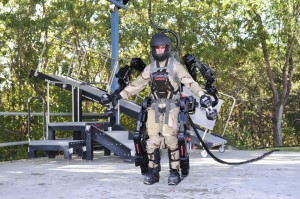Some of the wearables you’ll find on store shelves are ridiculous, and they don’t exactly fall into the category of “amazing futuristic gadgets”. That’s okay. They are a sign of things to come.
One day soon, smartwatches and fitness trackers will be obsolete. At that point we may have wearable smart clothes, smart furniture, and smart… well, everything. But if you think that idea of the wearable market is strange, wait until you hear about this next piece of tech.
A Japanese company created a wearable chair, called Archelis. Yep, you read that correctly.
The Archelis is designed to be worn by surgeons during long operating procedures, so that they can sit down while they work. Oddly, that’s not the only “wearable chair” that exists. Audi and Swiss-born Noonee have teamed up to create a “chairless chair” that factory workers can wear – and use – while they construct high-end vehicles.
While the wearable chairs aren’t “smart” in a technology sense, they are certainly wearable. Therefore, they still fit in the wearable technology space.
Wearable chairs aren’t futuristic at all, however. To earn the “futuristic gadgets” moniker, they would have to do something like transform into a portable transportation system, or provide voice activated controls.
But even if “wearable” chairs aren’t what you’d consider the future, there are plenty of amazing futuristic gadgets out there. You just have to be willing to look for them.
That’s exactly what we did. We searched high and low and put together a list of some of the most innovative – maybe even strange – futuristic gadgets and wearables.
10 Amazing Futuristic Gadgets You Can Wear Right Now
From extra-strong robotic exoskeletons, to tactical law enforcement tools that can see through walls there are quite a few amazing futuristic gadgets out there. Not all of them are necessarily affordable, but if you have the dough you can definitely get your hands on them and that’s all that matters.
Raytheon XOS 2 Exoskeleton
Would you consider a robotic exoskeleton/suit that affords super strength as something that belongs in the futuristic gadgets category?
The Raytheon XOS 2 exoskeleton has been around for a few years now – since 2010. It’s meant to be worn by military personnel and allows them to do some pretty amazing things.
While wearing the suit, soldiers can punch through walls or solid blocks of wood, and they can also lift extremely heavy objects without hurting themselves. For all intents and purposes, the Raytheon XOS is like a super suit.
Sadly, it’s powered by hydraulics so it requires a hefty hydraulic engine in order to work properly. Without the engine, it has no power. The technology isn’t at a point yet where folks can step into a suit and gain superpowers, but maybe someday soon!
Raytheon is currently working to create a version of the suit that is powered by a smaller, more portable internal engine.
Camero Xaver Tactical Devices
 There’s no question, during tactical situations it would be extremely useful to see what’s on the other side of a wall. Law enforcement, military, and anti-terrorism personnel could get a much better idea of what they’re walking into.
There’s no question, during tactical situations it would be extremely useful to see what’s on the other side of a wall. Law enforcement, military, and anti-terrorism personnel could get a much better idea of what they’re walking into.
They could scan to see if there are armed enemies on the other side of a wall, booby-traps, bombs, or just civilians.
The Camero Xaver product line is a series of portable devices that can do exactly that. They send out blasts of wide-band radiation, which allows them to detect what’s on the other side of a wall. Depending on the model, the user can even see a visual representation of what’s waiting for them.
There are three different versions, one of which is handheld, another is lightweight, and the last is a bulky 3D imaging tool.
In order for the Xaver devices to work properly, they must be pressed against the wall in question, and they take a few moments to return the results. Still, they work, and it’s not a stretch to believe that this technology will be improved over time.
Imagine what will happen if Camero figures out a way to shrink down these devices? Eventually, we may see a helmet or pair of goggles that can see through walls! Wouldn’t that be something?
The SoundHawk
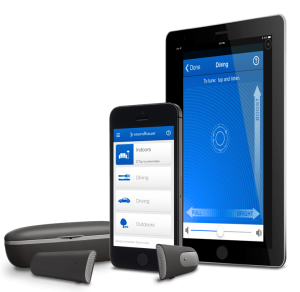 The SoundHawk is a unique device, designed to be like a hearing aid for those who are hard of hearing.
The SoundHawk is a unique device, designed to be like a hearing aid for those who are hard of hearing.
What makes it special, is that it can amplify nearby sound for the wearer allowing them to listen to conversations or noises, as if they were right in front of them.
What’s even more amazing is that the SoundHawk can eliminate background noise – like a pair of noise cancelling headphones – and isolate the sound of a single source. In other words, if someone is talking some distance away from you, the device can drown out background noise, and focus only on what they are saying.
Essentially, it provides the wearer with enhanced hearing abilities. Pretty amazing, right?
The SoundHawk can be controlled all through a smartphone app, like any other “smart” device. It works similar to a radio, tuning in on a particular frequency or sound profile.
Since the hardware is so small, it could be embedded in pretty much anything. Imagine if the SoundHawk technology were embedded into a hat, helmet, glasses, or some other kind of headwear? No one would even know you’re wearing it. To be honest, it looks a lot like a Bluetooth headset anyway, so even the device alone is pretty inconspicuous.
Martin Jetpack
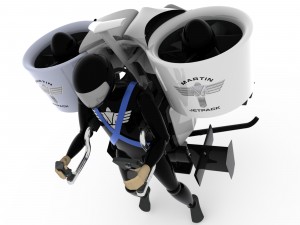 Have you ever wanted to fly, without sitting in an airplane? Just you, and nothing but the open sky above and below.
Have you ever wanted to fly, without sitting in an airplane? Just you, and nothing but the open sky above and below.
For about $170,000 to $280,000 you can own a personal jetpack that lets you soar, although probably not as high as you’d expect.
It’s called the Martin Jetpack, and with it, you can strap yourself in and go for a high-flying trip. Of course, the pack isn’t very compact. In fact, it’s gigantic. That’s because it employs two large-ducted fans that eject enough air to propel you higher. Worse yet, the jetpack is extremely loud and pretty, well unsightly. You won’t look like a badass flying around in this thing, you’ll look like a nerd.
That’s a small price to pay for some high-flying action though.
Wondering why the creators decided to use large fans instead of an engine? It’s safer. We can’t imagine anyone who would want to be strapped to a pack filled with jet fuel, considering how flammable it is and everything.
Still, the Martin Jetpack works! Maybe in a few years they will figure out a way to shrink it down in size? It would be like the movie The Rocketeer, only in real life!
DARPA’s Geckskin
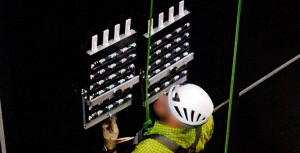 US Defense Agency DARPA has created a unique type of fabric called Geckskin as part of the Z-Man project. What is it, you ask?
US Defense Agency DARPA has created a unique type of fabric called Geckskin as part of the Z-Man project. What is it, you ask?
DARPA’s Geckskin project is responsible for the creation of climbing paddles, which have been lined with a special fabric modeled after the properties of a gecko’s sticky feet. With the paddles, you can scale any wall, even one made out of smooth, ridgeless glass. The cool thing about the paddles is that they don’t use any kind of special magnets or electric-based suction system.
One only needs to place the paddles against a surface and they will stick. That’s pretty amazing! Essentially, if you had these paddles you could turn into Spider-Man, without the web-slinging, obviously.
Sadly, there’s no talk of a consumer based version so you probably won’t be able to get your hands on the paddles anytime soon. DARPA is planning to create a special type of fabric using this technology which can be used to create military and tactical suits.
Vapshot
This next bit of tech isn’t as amazing as a super-strong exoskeleton, or a device that can see through walls, but it’s definitely something special.
It’s from a company called Vapshot, which specializes in producing vaporized alcohol machines. Why the hell would anyone want to consume vaporized alcohol you ask?
The buzz lasts for only 15 minutes at a time, and because the vapor instantly enters your bloodstream there’s little to no waiting time for the after effects.
If you’re the type of person that loves that buzzed feeling, but hates all the aftermath, then this technology is for you.
 The company offers several models, the smallest of which is called the Vapshot Mini (as if you couldn’t have guessed that name). You can purchase or rent the machines for an event, and it’s supposedly legal.
The company offers several models, the smallest of which is called the Vapshot Mini (as if you couldn’t have guessed that name). You can purchase or rent the machines for an event, and it’s supposedly legal.
How does it work?
The machine comes with bottles of vaporized alcohol, which look like nothing more than empty air. You take the Vapshot machine and put the injector into the bottle which prepares it for consumption. Then you “pop” off the cap like a Champagne bottle, and drink what’s inside. Most demos have shown users drinking the vaporized alcohol with a straw.
The vapor does have a taste which the company claims is “more aromatic and smooth” than if you had taken a straight shot of the same liquor or alcohol.
It’s certainly not glamorous, but neither is binge drinking.
US Army TALOS Project
The US Army’s TALOS project definitely belongs on our list of futuristic gadgets.
In 2013, the US Special Operations Command (SOCOM) and the Defense Advanced Research Projects Agency (DARPA) partnered up to create a high-tech, Iron Man style super suit for soldiers and military operators.
Defense One says that an early prototype of the suit included full ballistic protection, integrated heating and cooling systems, integrated sensors and computers, 3D audio support, and life-saving oxygen and hemorrhage controls, and that’s not all. It was also designed to be modular, or “holistic” so that new and better technology can be added once it shows up on the radar.
What is the TALOS exactly? In layman’s terms, it’s a super-suit akin to something Iron Man would wear. The ultimate goal is to completely protect those wearing the suit from any situation or contingency.
It’s also said to be outfitted with a remarkably unique type of electrically-stimulated shield, which was created by the Massachusetts Institute of Technology. This shield is called liquid body armor, and it can turn from a liquid into a solid, protective material in a matter of milliseconds through electrical stimulation. The wearer simply activates the electric current with a button or command and instantly the suit is protected from impact.
This definitely sounds far-fetched from where we’re sitting, but Lieutenant Commander and spokesman of SOCOM Matt Allen claims that a fully-operational prototype will be ready by sometime in 2018.
L’Oreal My UV Patch
 Believe it or not, L’Oreal – a company renowned for its beauty products – is responsible for a pretty cool piece of technology that taps into the Internet of Things (IoT). The My UV Patch is a temporary tattoo made out of “stretchable electronics” that is designed to adhere to the skin and measure UV exposure.
Believe it or not, L’Oreal – a company renowned for its beauty products – is responsible for a pretty cool piece of technology that taps into the Internet of Things (IoT). The My UV Patch is a temporary tattoo made out of “stretchable electronics” that is designed to adhere to the skin and measure UV exposure.
Obviously, the goal is to increase awareness about UV exposure, which can lead to several types of cancer, the most common of which is skin related.
The patch is a mere 50 micrometres thick which is about as thin as a single strand of hair. Needless to say, it’s pretty inconspicuous in terms of size.
You can apply the patch anywhere on your body, but obviously the best place is a portion that will be exposed to the sun. The patch changes colors to indicate varying levels of UV exposure, from extreme to acceptable. The dyes used are also designed to factor in the wearer’s skin tones, since lighter tones take more damage the longer they are exposed.
To check the current levels, one only needs to snap a photo of the patch through a compatible mobile app. It will analyze the dye colors and determine the current level of UV exposure.
It works with both Android and iOS devices, and is NFC enabled – which means you can tap an NFC-enabled device to the patch to setup an instant connection between the two.
A release date has not been set in stone for the My UV Patch yet, but L’Oreal will likely release it under their skincare brand, La Roche-Posay.
Trendwoo Freeman X6
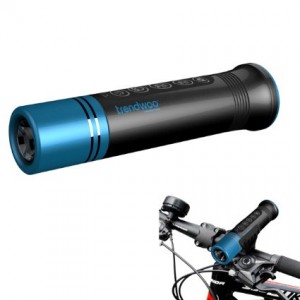 This next piece of tech on our list of futuristic gadgets is from Trendwoo. It is a little out of sorts when you compare to the rest of the devices on this list because it’s nothing more than a wireless Bluetooth speaker called the Freeman X6.
This next piece of tech on our list of futuristic gadgets is from Trendwoo. It is a little out of sorts when you compare to the rest of the devices on this list because it’s nothing more than a wireless Bluetooth speaker called the Freeman X6.
Why is it on the list, you ask? It features an impressive – and long – list of additional functions. This is a speaker that includes all the bells and whistles.
First things first, the Freeman X6 is designed to sit on the “kettle” or front handlebars of a bicycle. Don’t worry about it breaking if you crash, drop it, or if it falls off. The entire case of the speaker is made out of metal (aluminum), but the extra parts are made of polyoxymethylene which Trendoo says is “stronger than metal”.
It includes a selfie button so you can snap selfies of yourself on the move, a built-in microphone for hands-free calling and video chat support, an IP65 waterproof – and rainproof – rating, and a 2600 mAh rechargeable battery with an estimated 10 hours of playing time.
If you thought that was all, you were sadly mistaken. On the front end of the speaker is a CREE LED light (350 lumen) which can shine up to 250m away. You can detach the speaker and use it as a flashlight, or you can leave it attached to your bike as one bright headlight.
Finally, it’s equipped with a single 3W speaker that delivers “loud sound,” and you can sync up mobile devices via wireless Bluetooth, as you’d expect.
If you’re not impressed by all of that, we’re not sure what else to say. That is one device jam-packed with features. It’s probably not the last piece of tech we’ll see like this, which is why it made the list.
The Dash
 Sure, we already included a sound-related gadget thanks to the SoundHawk, but this next device is amazing – and fits neatly into the category of futuristic gadgets. Tired of wearing earbuds connected to a lengthy wire; one which happens to tangle at the most inopportune of moments?
Sure, we already included a sound-related gadget thanks to the SoundHawk, but this next device is amazing – and fits neatly into the category of futuristic gadgets. Tired of wearing earbuds connected to a lengthy wire; one which happens to tangle at the most inopportune of moments?
Tired of wearing earbuds connected to a lengthy wire; one which happens to tangle at the most inopportune of moments?
The Dash is the “world’s first” wireless smart earphones. It combines three different features you’d find in separate products all crammed into one. The Dash includes a standalone, one-touch music player, a live sports assistant, and smartphone companion support.
In other words, with this single pair of wireless earbuds, you can answer calls, listen to music, and call upon a virtual assistant for fitness info.
The Dash will last up to three hours on a single charge, however it comes with a charging case, and the case holds enough energy to juice up the headphones 5 more times. Altogether that’s a total of 18 hours of use.
They’re waterproof up to 1 meter, which means they’re safe to use while swimming and they include a myriad of sensors to track fitness data. Internal sensors include an optical touch sensor, accelerometer, gyroscope, and magnetometer. The sensor can track information like heart rate, steps, total activity time, and more.
Not only is Dash a miniscule wearable fitness tracker, it’s also a pair of high-quality earbuds. The future, my friends, is going to be fantastic! Wouldn’t you agree?
What Do You Think of These Futuristic Gadgets?
Do you feel unreasonably angry because you don’t think these are “futuristic gadgets” at all? Give us a shout! Let us know what you think of the list, and feel free to suggest any futuristic gadgets that you think should be mentioned!


